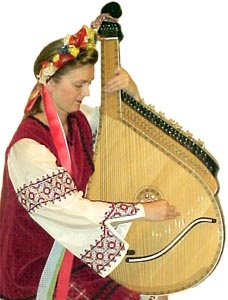bandura
musical instrument
also called kobza
 a stringed instrument of the psaltery family considered the national musical instrument of Ukraine. It is used chiefly to accompany folk music. The bandura has an oval wooden body; a short, fretless neck attached to the soundboard in an off-centre position; 4 to 8 bass strings running from the neck of the instrument to the body; and 30 or more (sometimes 60) chromatically tuned treble strings stretched over the soundboard. The instrument is played in a seated position, the body of the instrument held on the lap in a nearly vertical position parallel to the torso. The bass strings are plucked with the fingers of the left hand and the treble strings strummed with a plectrum held in the right hand.
a stringed instrument of the psaltery family considered the national musical instrument of Ukraine. It is used chiefly to accompany folk music. The bandura has an oval wooden body; a short, fretless neck attached to the soundboard in an off-centre position; 4 to 8 bass strings running from the neck of the instrument to the body; and 30 or more (sometimes 60) chromatically tuned treble strings stretched over the soundboard. The instrument is played in a seated position, the body of the instrument held on the lap in a nearly vertical position parallel to the torso. The bass strings are plucked with the fingers of the left hand and the treble strings strummed with a plectrum held in the right hand.A precursor to the bandura was the kobza, a three- to eight-string instrument mentioned in Greek literature of the 6th century. During the Middle Ages it was prominent in eastern European courts, where it was used to accompany singing and dancing. Additional strings were added to the kobza in the 14th or 15th century, when it became known as the bandura, but the term kobza remains a synonym for bandura. By the 15th century the bandura had been adopted by kobzari, professional musicians—many of whom were blind—who used the instrument as an accompaniment for epic ballads (dumy) that recounted the exploits of the Ukrainian Cossacks (Cossack). By the late 19th and early 20th centuries kobzari were persecuted for expressing nationalistic sentiments in their music, and in the 1930s Stalin ordered the execution of a number of them.
Despite Soviet censure, interest in the bandura increased in the 20th century. Many bandura ensembles and schools were formed, and the instrument, which was by tradition tuned diatonically, now has chromatically tuned versions. At the turn of the 21st century, bandura ensembles continued to be popular in Ukraine and in North American Ukrainian immigrant communities.
- jue
- juego de los voladores
- Juel, Niels
- Jugderdemidiin Gurragcha
- juge d'instruction
- Jugendstil
- juggler
- Juglar, Clément
- jugular vein
- Jugurtha
- Juhani Aho
- Juho Kusti Paasikivi
- Juigalpa
- Juilliard, Augustus D.
- Juilliard School
- Juin, Alphonse
- Juiz de Fora
- jujitsu
- jujube
- Jujuy
- juku
- Jukun
- Jule Gregory Charney
- Jules-Amédée Barbey d'Aurevilly
- Jules Barthélemy-Saint-Hilaire